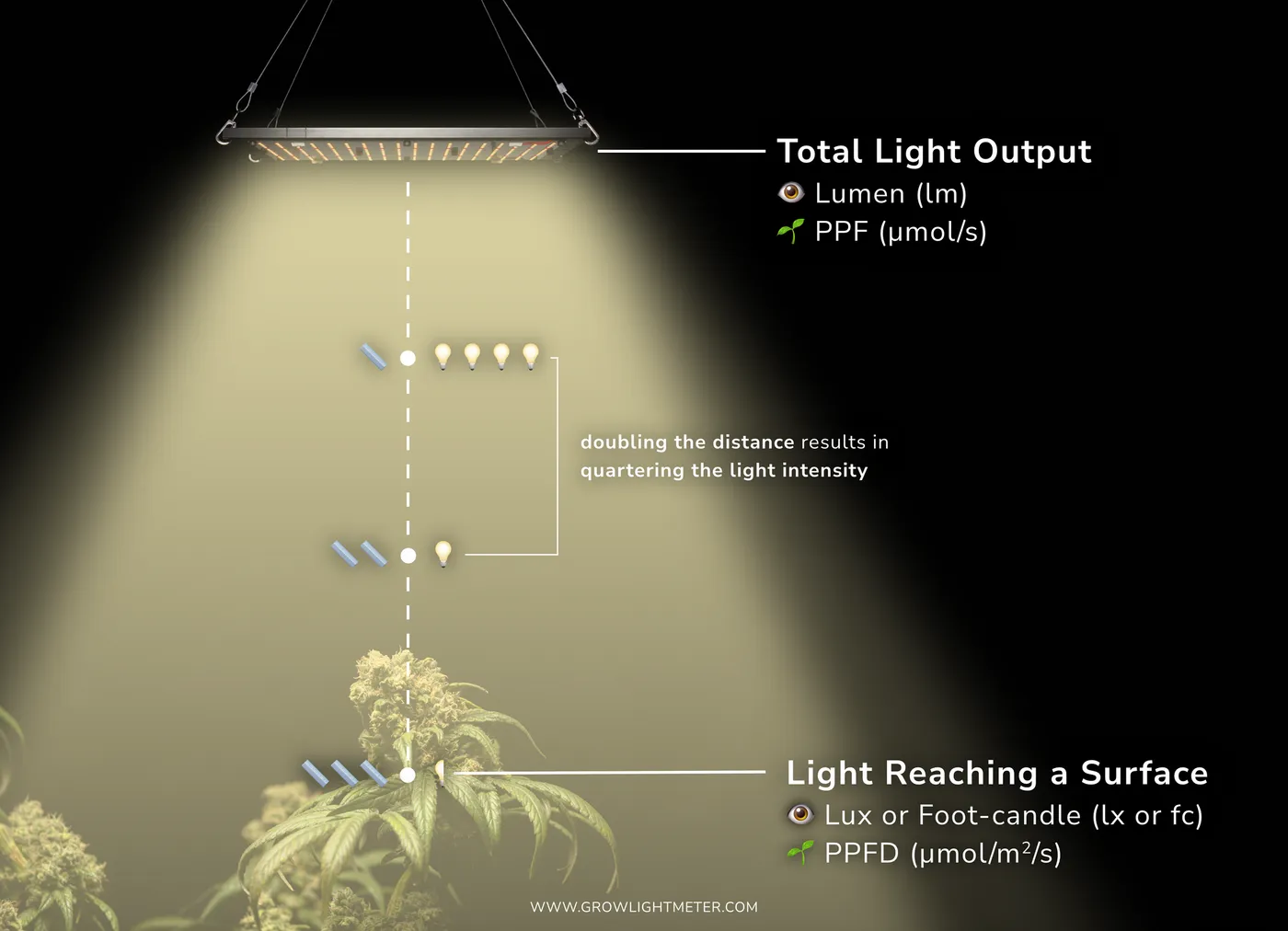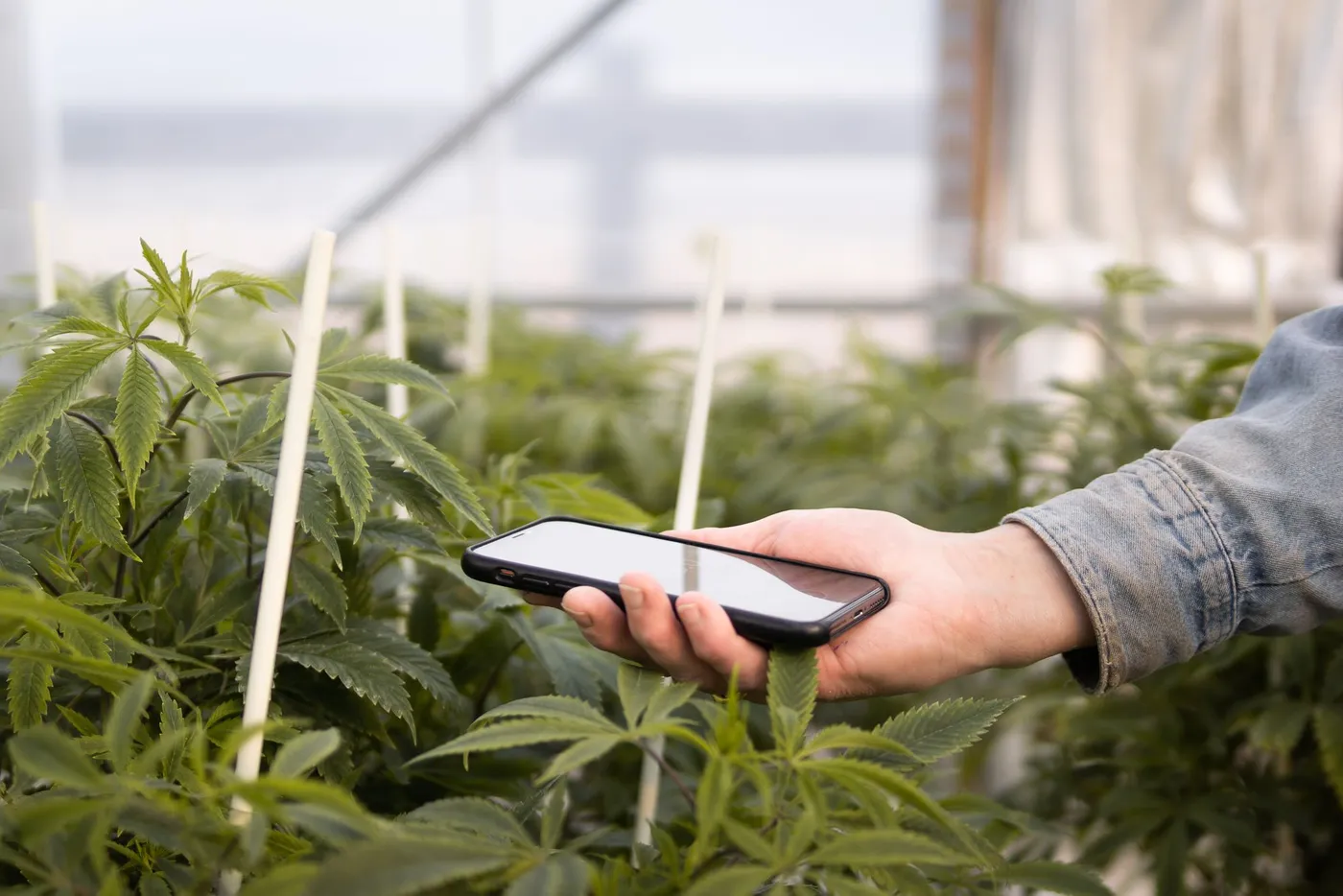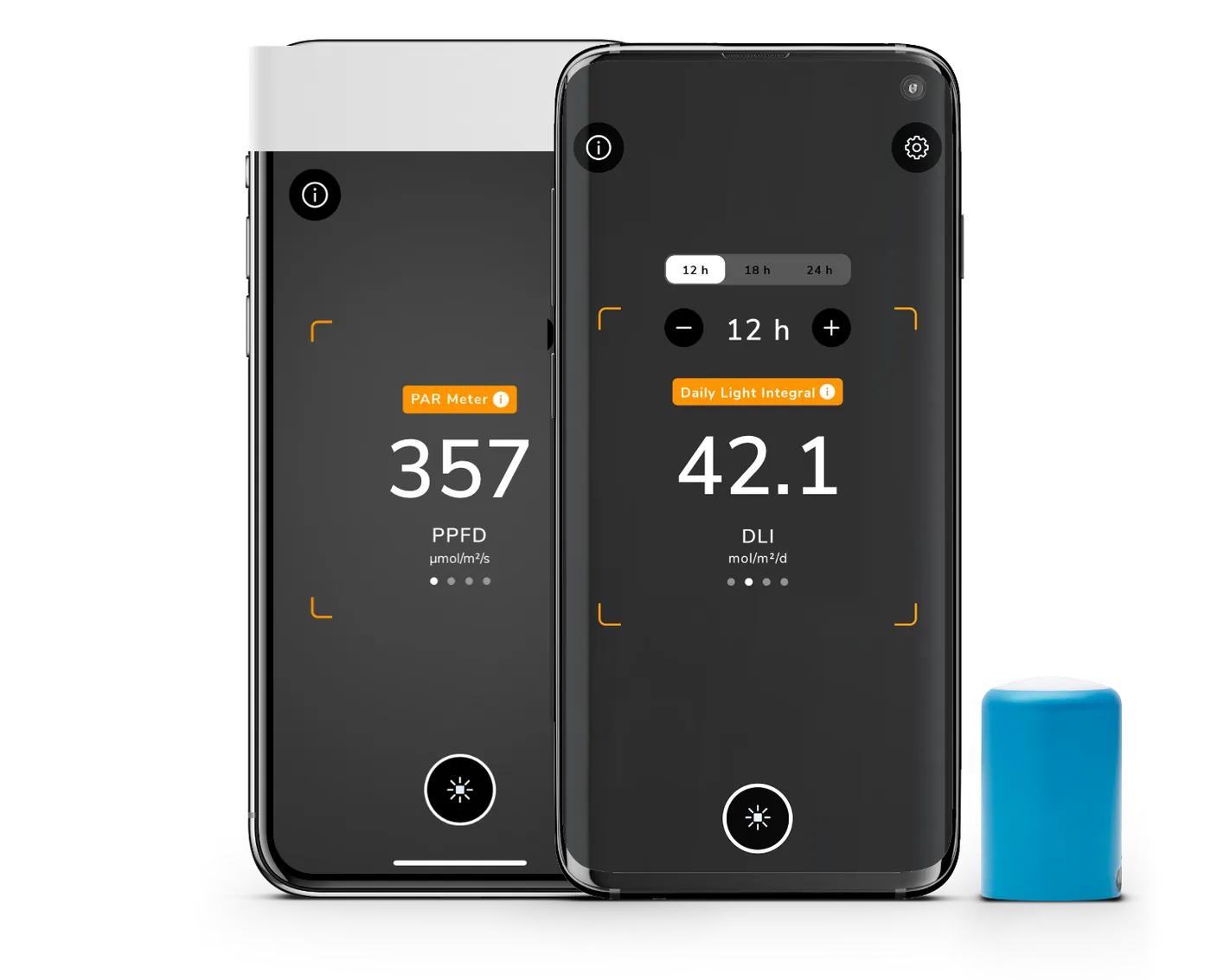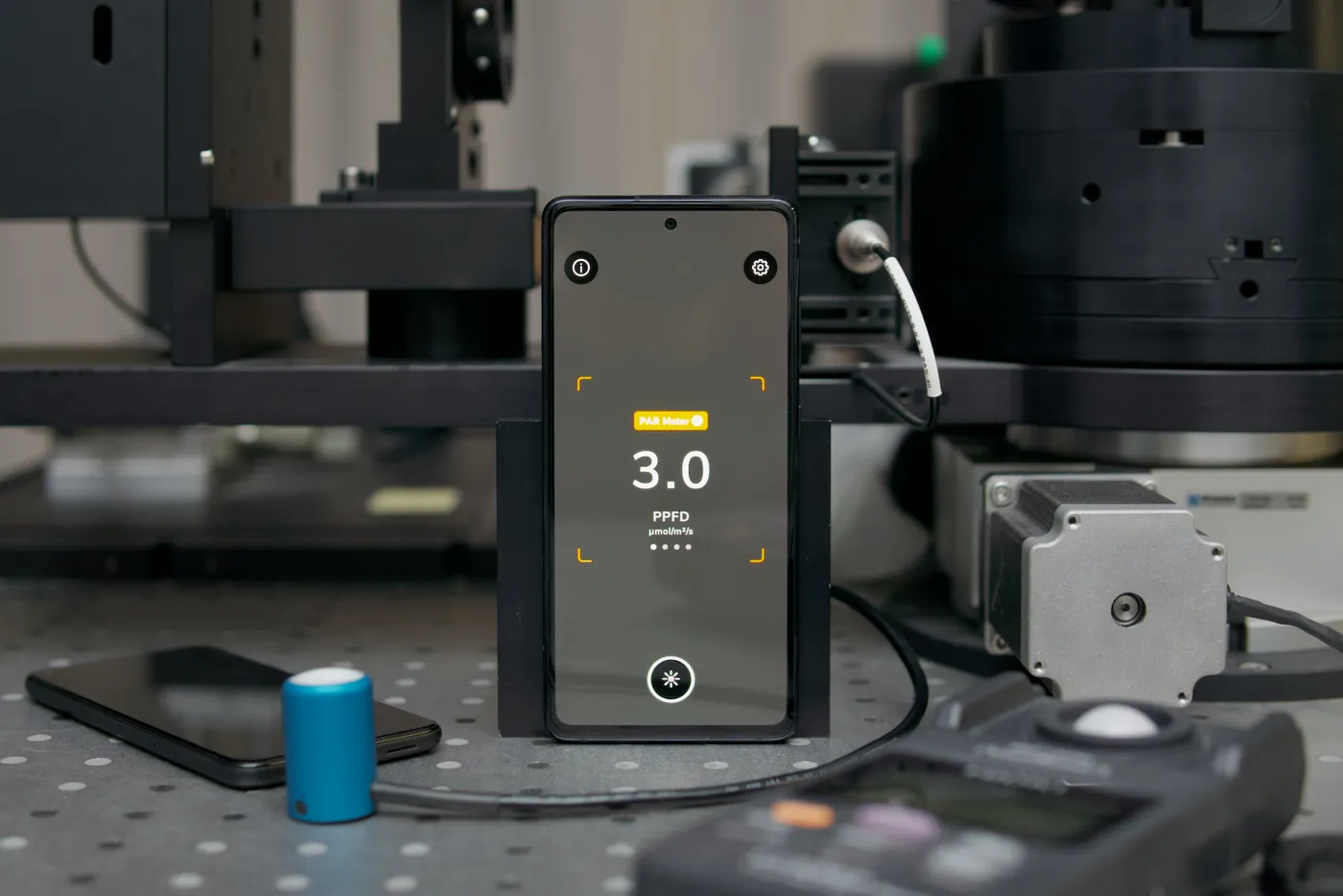
Auto-Translate
When it comes to growing plants indoors, the significance of PPFD, PAR, foot-candle (fc), and lux might seem confusing at first. Those measurements exist for two separate reasons: Where lux and foot-candle is used to measure light intensity, as it is perceived by humans, called illuminance. Light intensity usable by plants for photosynthesis is referred to as PPFD.
Indoor cultivators scramble to find the optimum light setting to ensure that their crops produce to the best of their ability; therefore it’s essential to understand the differences between these light measurements.
Read along to understand the difference between PPFD, PAR, foot-candle and lux so your indoor crop can thrive.
Contents
Illuminance
Illuminance is measured in lux (lx) or foot-candle (fc) and describes how much light, as perceived by humans, reaches a surface. The total light output of a lamp (i.e. its luminous flux) is measured in lumen (lm). Lux (lm/m²) is how many lumen reach a square meter whilst foot-candle (lm/ft²) describes lumen per square-foot.
The measured light spectrum is specifically tuned to accurately represent the perceived light by the human eye. It is therefore well suited for photography, architecture, and many more topics where humans or animals are involved.
Photosynthesis
Photosynthesis is the process in which plants transform light, water and carbon dioxide into oxygen and energy in the form of sugar. This is the key to how plants actually grow. Photosynthesis takes place in special cells which get excited by a certain wavelength or color of light. For the vast majority of green plants, photosynthesis is mostly taking place in the red and blue part of the spectrum. This is the reason why some LED grow lights provide mostly red and blue light instead of “full spectrum” white light, to reduce the electricity consumption for seemingly unnecessary light. Humans on the other hand perceive bluish or reddish light as less intense. This is why a lux-meter is the wrong tool of choice here, since it will measure light as perceived by the human eye.

Full- or broad spectrum grow lights are widespread nowadays, since they imitate the light of the sun i.e. the kind of light that plants would naturally grow under. It is also a much more pleasant light to work under and you’re able to check on your plant’s health much better. Full spectrum grow lights might still add some extra pure-red lights to boost growth. Therefore, a lux-meter will fail to measure this light’s spectrum as well.
PPFD and PAR
Light utilized by plants for photosynthesis is known as photosynthetically active radiation (PAR). PAR comprises photons (i.e. light particles) with wavelengths between 400 and 700 nanometers (nm).
The intensity of PAR reaching a surface, such as plant leaves, is quantified as photosynthetic photon flux density (PPFD). PPFD is typically measured in micromoles of photons per square meter per second (μmol/m²/s). This means that PPFD specifically measures the light available to plants for photosynthesis and thus, impacts their growth.

When measuring PPFD, for example by using our grow light meter app, you have the ability to take a glimpse into the world of functional light that matters to your plants. Now, with the help of actually measuring PPFD, you can immediately find out if your lighting is generating the optimum range of light for efficient photosynthesis.
Optimizing Light for Photosynthesis
Since light is among the most important factors for proper plant growth, measuring light intensity and coverage is crucial for maintaining an optimum plant count in the garden. If your indoor garden is overflowing with plants, then it’s likely that some plants are not receiving the proper light coverage.
By using an PAR / PPFD light meter, such as the Photone app, you can quickly discover the point of diminishing light intensity. This knowledge is incredibly helpful in increasing or decreasing the number of plants in the indoor garden.

When an indoor crop receives an abundance of light coverage, it’s likely that the yield will simultaneously increase to a certain point. However, the photosynthetic activity of a plant will get saturated at a certain level of light, where more light does not produce equally more yield anymore or the yield can even decrease.
The Optimal Amount
Every plant has its optimal amount of light, referred to by the measure of Daily Light Integral (DLI), which you should get to know and aim at. Providing more light than the DLI requires does not make much sense, whereas providing less light reduces your plants' yields.
To spare you the research process for finding the optimal lighting for your specific plant, we've created a simple DLI calculator with recommendations for light intensity and duration. When it comes to light measurement to optimize your grow room, there’s no easier choice than the versatile and accurate Photone app to simplify your indoor gardening life.
Which Measurement Should You Use?
Now that you know the differences between the units of light measurement, which one will you use?
Whenever dealing with lighting conditions of plants, lux and foot-candle might not accurately represent the real light intensity suitable for photosynthesis. If you’re seeking to reach the optimum lighting for your plants (represented by PAR) then measure PPFD. You may still measure lux or foot-candle to compare your results to measurements taken by other people that are not as smart as you are now ;)
Indoor plants require much more care than outdoor plants because all lighting is supplemented. Since every aspect of the growth process is in your hands, it’s essential to monitor how much or how little light your plant receives.
Other Metrics
You might have heard of other plant lighting related abbreviations such as ePAR, PPE, PPF, YPF, YPFD or the McCree curve. We've explained all of them to you in our grow light metrics glossary:

Measuring Light Easily
If you've read this far, you're most likely interested in using all these light measurements to your advantage. To measure light accurately, easily, and even for free, we highly recommend giving our app a try.
With all light measurements available on our single app, you can now use them to your advantage. Thank you for reading!


 Share This
Share This











